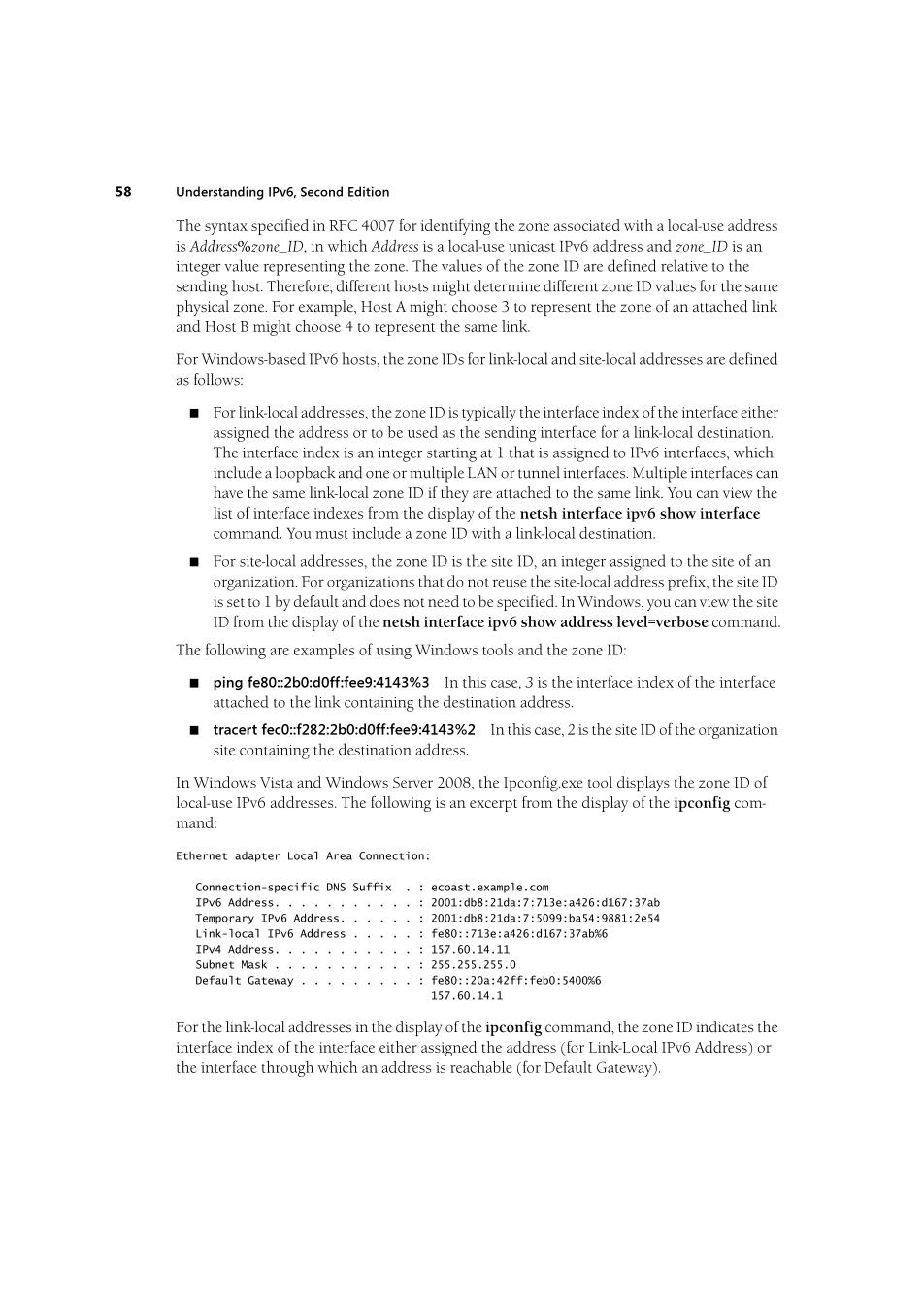正在加载图片...

58 Understanding IPv6,Second Edition The syntax specified in RFC 4007 for identifying the zone associated with a local-use address is Address%zone ID.in which Address is a local-use unicast IPv6 address and zone ID is an integer value representing the zone.The values of the zone ID are defined relative to the sending host.Therefore,different hosts might determine different zone ID values for the same physical zone.For example,Host A might choose 3 to represent the zone of an attached link and Host B might choose 4 to represent the same link. For Windows-based IPv6 hosts,the zone IDs for link-local and site-local addresses are defined as follows: For link-local addresses,the zone ID is typically the interface index of the interface either assigned the address or to be used as the sending interface for a link-local destination. The interface index is an integer starting at 1 that is assigned to IPv6 interfaces,which include a loopback and one or multiple LAN or tunnel interfaces.Multiple interfaces can have the same link-local zone ID if they are attached to the same link.You can view the list of interface indexes from the display of the netsh interface ipv6 show interface command.You must include a zone ID with a link-local destination. For site-local addresses,the zone ID is the site ID,an integer assigned to the site of an organization.For organizations that do not reuse the site-local address prefix,the site ID is set to I by default and does not need to be specified.In Windows,you can view the site ID from the display of the netsh interface ipv6 show address level=verbose command. The following are examples of using Windows tools and the zone ID: ping fe80::2b0:doff:fee9:4143%3 In this case,3 is the interface index of the interface attached to the link containing the destination address. tracert feco::f282:2b0:doff:fee9:4143%2 In this case,2 is the site ID of the organization site containing the destination address. In Windows Vista and Windows Server 2008,the Ipconfig.exe tool displays the zone ID of local-use IPv6 addresses.The following is an excerpt from the display of the ipconfig com- mand: Ethernet adapter Local Area Connection: Connection-specific DNS Suffix.:ecoast.example.com IPv6 Address,··,·,,·,·,:2001:db8:21da:7:713e:a426:d167:37ab Temporary IPv6 Address......:2001:db8:21da:7:5099:ba54:9881:2e54 Link-local IPv6 Address.....:fe80::713e:a426:d167:37ab%6 IPv4 Address.····,····,:157.60.14.11 Subnet Mask······,.···:255.255.255.0 Default Gateway.........fe80:20a:42ff:feb0:5400%6 157,60.14.1 For the link-local addresses in the display of the ipconfig command,the zone ID indicates the interface index of the interface either assigned the address (for Link-Local IPv6 Address)or the interface through which an address is reachable(for Default Gateway).
!"#"$ "
%&' ())* #+, "$
"#"
-
.+
+!"
$ /"
0+!
012
$$, " 344567789:;6<=>? "
/"! 3445677 "
0+!
012 2
"!
@ABC
$$,
$ 9:;6<=> "
"
-, B
02 , ,
"
-
.+
D B
02 +#
.+
@E
, $#"
$ ,0
"B
+
$"
-+
D ,#+,? $"##,
+
F"-
$
,F"
$"##,
.+
@E B
02 #+,
F "!
0 .+
D &+,
F 0? G+
H F"-
!++ I
+ , ,
.+
+#
!$ 0"
J
$ G+
K F"-
!++ (
+ , ,
F 0"
JD &+, L"
$+/1M
$ @ABC +
?
.+
@E #+, 0"
J10+!
0
$ "
10+!
0
$$,
, $#"
$
#+00+/N O &+, 0"
J10+!
0
$$,?
.+
@E "
"!
00
"
,#
! "
$ +#
"
,#
! "
,
"-
$
$$, +,
+ M 2$
$"
- "
,#
! #+,
0"
J10+!
0 $
"
"+
D "
,#
! "
$ "
"
-,
,
"
-
P
"
"-
$
+ @ABC "
,#
!? /"! "
!02$
0++ M
!J
$ +
+, F20
" 0 QHR +,
2
0 "
,#
!D S20
" 0 "
,#
! !
B
F 0"
J10+!
0 .+
@E "#
,
!$
+
F 0"
JD T+2 !
B"/
0"
+# "
,#
! "
$ #,+F
$" 0
+#
UVWXY ZUWV[\]^V Z_`a XYbc ZUWV[\]^V !+FF
$D T+2 F2
"
!02$
.+
@E /"
0"
J10+!
0 $
"
"+
D O &+, "
10+!
0
$$,?
.+
@E "
"
@E?
"
-,
"-
$
+
"
+#
+,-
".
"+
D &+, +,-
".
"+
$+
+
,2
"
10+!
0
$$, ,#" ?
"
@E "
+ P M $#
20
$ $+
+
$
+ M !"#"$D @
L"
$+/? +2 !
B"/
"
@E #,+F
$" 0
+#
UVWXY ZUWV[\]^V Z_`a XYbc ]dd[VXX eV`Vef`V[gbXV !+FF
$D #+00+/"
-
,
F 0 +# 2"
- L"
$+/
++0
$
.+
@EN O h
ijkllmnklkiiliolpqprsr @
" !
? t "
"
,#
! "
$ +#
"
,#
!
!$
+
0"
J !+
"
"
-
$
"
"+
$$,D O ikllimjmlmnklkiiliolpqprsm @
" !
? u "
"
@E +#
+,-
".
"+
"
!+
"
"
-
$
"
"+
$$,D @
L"
$+/ v"
$ L"
$+/ w,B, x))y?
@ !+
#"-D
++0 $" 0
.+
@E +# 0+!
012 @ABC
$$,D #+00+/"
- "
!,
#,+F
$" 0
+#
Z_^bU\Zz !+F1 F
$N {|}~~| |~
~
~|
~|
~ ~
|~~
~ ~¡ ¢~
£ ~¤¥¥¤¡¥~¤¡ ¦
~~ ~¡ § ¡ ~¤¡ ~| ¨¦¤¤¤¤¤¤ ~| ©|~ª£~¡~¤¡§ ¤¡ &+,
0"
J10+!
0
$$, "
$" 0
+#
Z_^bU\Zz !+FF
$?
.+
@E "
$"!
"
,#
! "
$ +#
"
,#
! "
,
"-
$
$$, «#+, Q"
J1Q+!
0 @ABC H$$,¬ +,
"
,#
!
,+2- /"!
$$, " ,
!
M0 «#+, E#
20
/
¬D���������������������������������������������������������������������������������